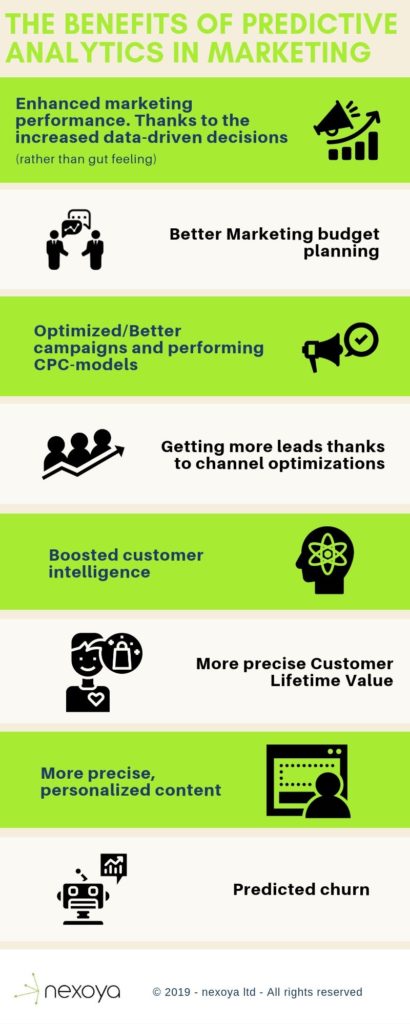Nowadays digital marketing is becoming more and more AI-driven. Thanks to artificial intelligence (AI), marketing has propelled content and advertisement personalization into a totally new level. Moreover, AI technologies also helped to enhance the marketing analytics practice.
Understanding marketing analytics is crucial since it helps marketers to measure, manage and analyze marketing performance to in order to maximize its effectiveness and optimize return on investment (ROI). As a result, marketing analytics allows marketers to be more efficient. However, this process can be enhanced even more with the use of artificial intelligence.
What are the main trends driving marketing analytics?
AI marketing tools for various marketing disciplines, such as content curation, email marketing or content generation have already “turned to AI”. This has helped marketers to become more efficient in their daily work by eliminating the need of focussing on repetitive tasks, such as reporting, performance monitoring, organizing and analyzing marketing data.
Marketing analytics have changed as well over the years, especially by introducing predictive analytics into the digital marketing world.
With predictive analytics, marketers can see trends and get estimations of how their marketing campaigns will most likely perform. This information can be very beneficial to marketers because their efforts won’t be wasted. They will have the chance to implement the necessary changes in order to increase the likelihood of reaching the set goal for a marketing campaign on time. Thus, artificial intelligence helped to simplify and at the same time optimize marketing analytics practice.
Historical data is the key to predictive analytics in marketing

Predictive analytics algorithms are based on historical data gathered from various marketing channels and tools. This data is fundamental to building up good quality algorithms and getting high-quality predictions.
There are various ways in which a predictive analytics algorithm can be implemented and the methods that can be used. It can be either sophisticated artificial intelligence/deep learning models or more simple functions. The quality of the end results depends heavily on the data and the selection of the best model for it.
Now we’ll give you a short guidelines into the general steps on how you can improve your marketing analytics:
The process of implementing predictive analytics in marketing:
1. Data Collection & Cleaning
In the first step, we need to gather historical data. Most data used in predictive analytics is time-based, certain numbers which occur over time. It is also known as a “time-series”. At this stage, we need to make sure we have all the data in one place and clean it accordingly.
2. Transformation & Selection
In the second step, we transform all the different time-series into the same format and then select the ones which make sense in order to combine them. It is sensible to combine multiple metrics in order to predict one certain metric. This is called multivariate prediction and will most of the time allow us to increase the quality of our predictions.
3. Model Selection & Training
As the next step, we select the best model for our predictive analysis. The model choice heavily depends on the use case and how your data “looks like”. At nexoya, we automatically detect the pattern for your time-series and dynamically select the best model for your predictive analytics depending on the measurement itself (i.e. Is it the number of opened emails or impressions on your blog) and various other factors like trends or weather.
4. Model Evaluation
As the last step, we measure the quality of our prediction and start to constantly improve the algorithm or adjust the model/ if needed.
To learn more about the preparation of data and how an AI Model is built, check our previous blog on ”How to create an AI model?”and ”Learn how to make your data ready for AI with 5 simple steps”.
Why do marketers want to use predictive analytics in marketing?
Why are predictions so important for marketing analytics? Marketers have access to an enormous amount of historical data. Savvy marketers want to understand and take advantage of all the available data and get the best out of it. That includes getting insights into the future development and trends of their marketing efforts and channels.
With the support of predictive analytics in marketing, marketers can better understand what channels work and how their numbers evolve. This allows them to anticipate customers’ needs and their digital behaviour.
8 Benefits of predictive analytics in marketing (listed)
Below you can find a short list of the Benefits of Predictive analytics in Marketing:

With predictive analytics in marketing, marketers can obviously benefit a lot and base their decisions on arguments that, again, are based on data. Nexoya offers predictive analytics for digital marketers, helping them to optimize their marketing while being able to identify trends of their most important KPIs early on.
An integrated digital marketing strategy is highly beneficial to your business, as it allows you to spread your message across channels.
But how can artificial intelligence help you to execute your integrated marketing plan?
In our newest article, you will find out how to start planning an Integrated Marketing Strategy and where AI can support you in executing your strategy.
Infographic – Predictive analytics in marketing (Text version)
1. Enhanced marketing performance. Thanks to the increased data-driven decisions (rather than a gut feeling)
2. Better Marketing Budget planning thanks to predictive analytics in marketing
3. Optimized campaigns and performing CPC-models because of predictive analytics in marketing
4. Getting more leads thanks to channel optimizations
5. Boosted customer intelligence through predictive analytics in marketing
6. More precise Customer Lifetime Value due to predictive analytics in marketing
7. More precise, personalized content thanks to predictive analytics
8. Predicted churn
How to use predictive analytics in marketing for better marketing performance
Predictive analytics is being progressively adopted into marketing operations and many companies already experience positive results.
We have prepared a list of the most popular predictive analytics applications that ensure better marketing performance.
Digital marketers can benefits from Predictive analytics in marketing by applying it in the following marketing processes:
- Thanks to predictive analytics, marketers can better understand their target audience and its behaviour based on historic data analysis. This brings personalisation to the next level and ensures more effective communication strategy with potential and existing clients. As a result, it improves customer acquisition and retention processes.
- Marketers can use predictive analytics in marketing for optimizing their marketing budgets for more efficient performance. Take a look at the case study where budget allocation based on predictive analytics improved converions by 70%.
- More efficient client acquisition process. Thanks to predictive analytics digital marketers can improve their customer acquisition process, since potential customers can be reached based on for example bench-mark data or open source data. Read more about client acquisition with predictive analytics here.
- Predictive analytics in marketing allows you to detect unseen or unpredictable events in your data in an early phase and react immediately. As an example, a marketer might see that the CTR for a specific landing page has increased, which is generally a good sign. Nevertheless, the bounce rate for the same landing page had also increased significantly. Therefore, an increase in CTR will not bring as much value if the bounce rate goes up. Looking at many different KPIs that give a better overview of the entire situation will help the marketer to improve such details that might be unseen at first sight.